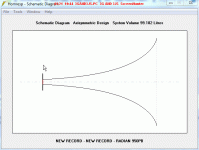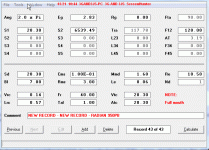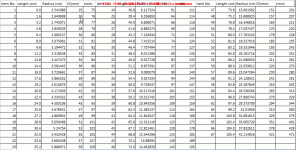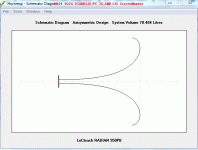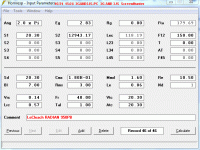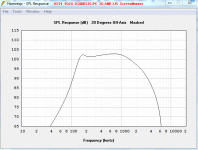It will only be used to 1khz, then maybe a yamaha 6681, Vitavox S2(if they are rereleased), TAD 2001 or anything else which comes along🙂
It will only be used to 1khz, then maybe a yamaha 6681, Vitavox S2(if they are rereleased), TAD 2001 or anything else which comes along🙂
i ordered recently a pair of Beyma TPL 150's. When they arrive, i will make a wave guide for them, and compare them with the Vitavox S2/Coral H104.
Who knows, maibe they will remain....
I wrote Mike Harvey from Octave Audio yesterday, after i read the news at 6 moons, to ask for pricing for the new production of Vitavox, but no answer so far. I am not sure if 6 moons news was based on direct information from Octave Audio......
What will you use in the gap from 130/150Hz that you initially discussed? Do not cross the 950 below 300Hz.
Not sure yet, I am open to ideas.
The horns are for a new room which is yet to be designed so we have an open slate here for everyone to help me 🙂
The horns are for a new room which is yet to be designed so we have an open slate here for everyone to help me 🙂
The Vitavox bass bin looks like it may be worth considering. When i am not so tired I will try and get some ideas together and look at the system as a whole.
Hey 3GGG
Just come back from hols ...
Why would you not use Radian 950pb on something like an Azurahorn 425 from 700Hz up ; and then build your wooden horn with the 18-Sound 10" driver or one of the other 8" drivers JLH suggested , to go from ~120 to 700 ... ??
This is roughly what I'm doing, although I'm using GPA 288H/Azura425 .
Mark
Just come back from hols ...
Why would you not use Radian 950pb on something like an Azurahorn 425 from 700Hz up ; and then build your wooden horn with the 18-Sound 10" driver or one of the other 8" drivers JLH suggested , to go from ~120 to 700 ... ??
This is roughly what I'm doing, although I'm using GPA 288H/Azura425 .
Mark
Mark, the idea of a 10" in a big horn and then the Radian has alot of merit. The price of the Radins is nice so they may well get the first call up fot the smaller horn. Since i am building the horns I have a degree of flexibility in the size of the throat.
I havent been able to get Hornresp to show much response down to 120 hz though.
I dont know what will be harder, building the things or deciding what to build!
I havent been able to get Hornresp to show much response down to 120 hz though.
I dont know what will be harder, building the things or deciding what to build!
Hey 3GGG
Just come back from hols ...
Why would you not use Radian 950pb on something like an Azurahorn 425 from 700Hz up ; and then build your wooden horn with the 18-Sound 10" driver or one of the other 8" drivers JLH suggested , to go from ~120 to 700 ... ??
This is roughly what I'm doing, although I'm using GPA 288H/Azura425 .
Mark
hi Mark
what is in your view the advantage of using a paper cone, instead of a compression driver, in this frequency range ( beside more extension downward, of course ) ?
Have you ever made direct comparisons ?
John
have you actually tried it out ? I never got disturbed about beaming with this combo.....
Yes, I've tried it. That's why I made the comment. Long low frequency horns and compression drivers are not my idea of good sound quality. If your going to be using a compression driver up high in frequency, then you need a horn better suited to optimize it in high frequencies. Larger horns are only optimized for the lower frequencies.
Ill be using a large horn down low and a 320hz (approx) up high. Now I am thinking of maybe 8-10" in a 120hz horn then maybe a 2" compression driver in a 350hz tractrix then maybe a 1" driver in a smaller again horn, plus a tweeter above 10k. I think Cessaro make a horn like these.
I may use a tractrix for the 130hz horn and LeCleach profile for the smaller horns.
trying to finalise a design then plot it is giving me the Sh$#s!
trying to finalise a design then plot it is giving me the Sh$#s!
Hi Chaps
Well, it sounds possible but a bit more complex, 3GGG .
Angelo, I was just suggesting the more conventional approach that has some established history with a few people whose results I have firm data on . I can see some obvious technical problems with using something like a 950Pb down to 150-200Hz as John has said . If 3GGG has the time and money to experiment with this then so be it . I know you have enthusiasm for this sort of approach , and I know you've done a lot more in this field than I have .
Personally , one useful thing to establish is how high your hearing goes.
I can almost do without a tweeter on the 288/Azura because they go to 12-13k ( admittedly beaming ) and my hearing gives up at 15k . I will still be using a tweeter ( B&C DE35 ) to get more spread above 8k .
However... if you're using a 1" driver on a smaller horn up top, I'd say you could avoid a tweeter at all if you choose the right driver, then perhaps spread the lower channels differently below .
Mark
Well, it sounds possible but a bit more complex, 3GGG .
Angelo, I was just suggesting the more conventional approach that has some established history with a few people whose results I have firm data on . I can see some obvious technical problems with using something like a 950Pb down to 150-200Hz as John has said . If 3GGG has the time and money to experiment with this then so be it . I know you have enthusiasm for this sort of approach , and I know you've done a lot more in this field than I have .
Personally , one useful thing to establish is how high your hearing goes.
I can almost do without a tweeter on the 288/Azura because they go to 12-13k ( admittedly beaming ) and my hearing gives up at 15k . I will still be using a tweeter ( B&C DE35 ) to get more spread above 8k .
However... if you're using a 1" driver on a smaller horn up top, I'd say you could avoid a tweeter at all if you choose the right driver, then perhaps spread the lower channels differently below .
Mark
Angelo, what are your thoughts on an 8" or 10" crossed at maybe 150hz to maybe 600hz then getting the Radian to step in?
I have read the Radian hasn't got the smoothest upper range, If I am correct you had the Radian in your upper horn before replacing it with the S2, if so how high did you run it in this application?
I have read the Radian hasn't got the smoothest upper range, If I am correct you had the Radian in your upper horn before replacing it with the S2, if so how high did you run it in this application?
hi guys
my comments do not rely on measured data, but entirely on subjective/practical approach , aka. listening and comparing. What i bring up here, is just a personal opinion. So what i feel sounds good to me, does not necessarly mean, it has to sound good to others. I do cross the Radian not at 150hz, but at 300hz. Below 300hz, in my view, it runs out of steam.
The Fane Studio 8M i used previously did sound good as well, but the Radian sounds " cleaner " , probably better transients, " faster ", more clarity, and what i most apprechiate, it integrates very well with the other horn channels - aka sound signature is the same . In direct comparisons with the Vitavox S2, i think the Vitavox sounds slighty more natural, and since it has a natural rolloff starting above 10khz, it integrates very well with the Coral H104 i use in the treble range. I made comparison between the 1" Celestion 1425, and the Coral. I think the best solution for treble is not to use a 1" compression driver, but a dedicated tweeter, which has more extension in the higher frequency range, and a wider dispersion.
what advantage do you expect, having your lower midrange channel crossed at 150hz, instead of 300hz ?
my comments do not rely on measured data, but entirely on subjective/practical approach , aka. listening and comparing. What i bring up here, is just a personal opinion. So what i feel sounds good to me, does not necessarly mean, it has to sound good to others. I do cross the Radian not at 150hz, but at 300hz. Below 300hz, in my view, it runs out of steam.
The Fane Studio 8M i used previously did sound good as well, but the Radian sounds " cleaner " , probably better transients, " faster ", more clarity, and what i most apprechiate, it integrates very well with the other horn channels - aka sound signature is the same . In direct comparisons with the Vitavox S2, i think the Vitavox sounds slighty more natural, and since it has a natural rolloff starting above 10khz, it integrates very well with the Coral H104 i use in the treble range. I made comparison between the 1" Celestion 1425, and the Coral. I think the best solution for treble is not to use a 1" compression driver, but a dedicated tweeter, which has more extension in the higher frequency range, and a wider dispersion.
Angelo, what are your thoughts on an 8" or 10" crossed at maybe 150hz to maybe 600hz then getting the Radian to step in?
I have read the Radian hasn't got the smoothest upper range, If I am correct you had the Radian in your upper horn before replacing it with the S2, if so how high did you run it in this application?
what advantage do you expect, having your lower midrange channel crossed at 150hz, instead of 300hz ?
Last edited:
"what advantage do you expect, having your lower midrange channel crossed at 150hz, instead of 300hz ? "
I suppose I wanted the horns to cover as much range as possible and to keep the lowest channel down to one unit.
I havent ried simulating the lowest channel yet as this may be built in to a new dwelling, or I may just build a big, two metre tall free standing "short horn".
If I recall correctly you drew up a design where the (conical) horns are mounted to a single driver horn with one fold in it. I looked online for an hour or so and couldnt find it again.
I suppose I wanted the horns to cover as much range as possible and to keep the lowest channel down to one unit.
I havent ried simulating the lowest channel yet as this may be built in to a new dwelling, or I may just build a big, two metre tall free standing "short horn".
If I recall correctly you drew up a design where the (conical) horns are mounted to a single driver horn with one fold in it. I looked online for an hour or so and couldnt find it again.
"what advantage do you expect, having your lower midrange channel crossed at 150hz, instead of 300hz ? "
I suppose I wanted the horns to cover as much range as possible and to keep the lowest channel down to one unit.
I havent ried simulating the lowest channel yet as this may be built in to a new dwelling, or I may just build a big, two metre tall free standing "short horn".
If I recall correctly you drew up a design where the (conical) horns are mounted to a single driver horn with one fold in it. I looked online for an hour or so and couldnt find it again.
I don't remember the drawing you are mentioning.
If i had to choose and build a basshorn now, i would think in scaled down Vitavox Bassbin, with double horn throat , which permits a more even dispersion in the vertical line, and loading the room better.
What i don't forget, is the performance of Mario's ( audiofilofine ) Onken W with double Altec 816a woofers, crossed at 800 hz (!!) which i heard last year . According to Marios evalutaion, 500hz crossover to midrange is even better. That is a different approach, but midbass did sound amazingly well, and no sub needed. It goes down to below 40hz effortlessly. Something like that looks pretty interesting to me :
Odyssey Stratos owner review
I have made the decision to try the Radian driver in a 130hz tractrix horn. It will be 105cm long and 84cm in diameter.
Angelo, if I can not get hold of a suitable vintage driver what is your opinion on using a secong Radian driver for the 320/350hz upper mid horn?
Angelo, if I can not get hold of a suitable vintage driver what is your opinion on using a secong Radian driver for the 320/350hz upper mid horn?
Attachments
Last edited:
- Status
- Not open for further replies.
- Home
- Loudspeakers
- Multi-Way
- Best 8" to 12" driver for 130hz tractrix horn
